1 Electric force – Coulomb’s law
A point charge is a hypothetical charged particle that occupies a single point in space. It has no internal structure, motion or spin, so a stationary point charge is only affected by electric fields and not affected by magnetism. It is useful when defining the concept of electric force.
Definition of the electric force: The electric force is defined as the electromagnetic force on a stationary point charge.
It is important to keep in mind, however, that the electric force is experienced not only by stationary point charges. The electric force is felt by all charges, whether they are moving or not.
Before looking at the electric force in more detail, it is useful to consider forces in general. Unlike charge, force is a vector quantity – it has a magnitude and a direction – and its conventional symbol is . The SI unit of force is the newton (N), where 1 N is equivalent to 1 kg m s.
Newton’s second law of motion states that the force on a particle is equal to its rate of change of momentum or, when the force is applied to a body with a mass that does not change with time, its mass m multiplied by its acceleration . Mathematically this is written as
Equation 1 gives an example of a vector quantity (in this case acceleration) multiplied by a scalar quantity (mass). The result of this operation is another vector (force).
Multiplying a vector by a scalar
If any vector is multiplied by any scalar , the result is another vector . The magnitude of is equal to the scalar factor multiplied by the magnitude of the original vector. You can express this as or .
If the scalar factor is positive then the product will be parallel to the original vector. If the scalar factor is negative then the product will be antiparallel to the original vector (Figure 1).
Also note the following general points, where could represent any vector.
The quantity
Equation label: (2)is a vector of magnitude 1 (with no units) pointing in the same direction as . This vector is called the unit vector of and is given the symbol (pronounced F-hat).
Writing
Equation label: (3)neatly splits a vector into a product of two terms:
gives the magnitude of the vector
gives its direction in space.
The units of are contained in the magnitude, . Any unit vector is dimensionless and has magnitude 1; not 1 newton or 1 of anything else.
Two vectors with the same magnitude and the same direction are defined as being equal, but remember that they can have different starting points.
The study of time-independent (static) electrical phenomena is known as electrostatics. The sections that follow focus on the electric force between static point charges. This so-called electrostatic force between two stationary point charges is given by Coulomb’s law, which has the following observable properties.
Properties of Coulomb’s law
The electrostatic force between two stationary point charges:
acts along the line of separation between the charges
is repulsive for charges of the same sign and attractive for charges of opposite sign
has a magnitude that is proportional to the product of the charges and inversely proportional to the square of the distance between the charges.
In mathematical form, the scalar part of the electrostatic force , acting on the line of separation between two charges, and , separated by a distance is written as
where is a positive constant that will be defined later in this course. The denominator in Equation 4 characterises this expression as an inverse square law.
If and have the same sign, then Equation 4 predicts . This is interpreted as a repulsive force.
-
What is the sign of if and have opposite signs? How is this interpreted?
-
If and have opposite signs, then . This is an attractive force.

